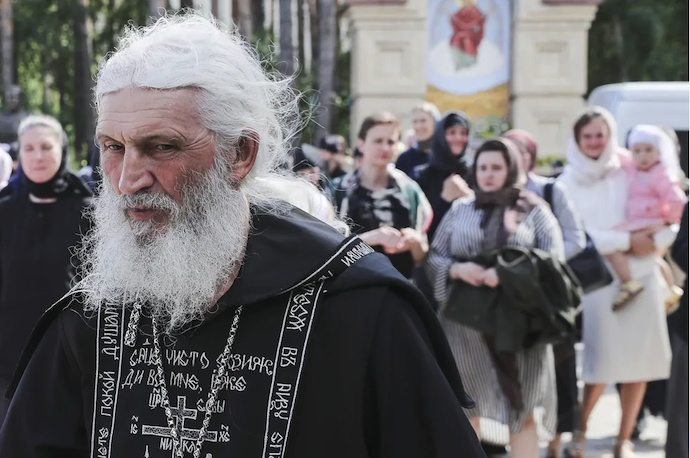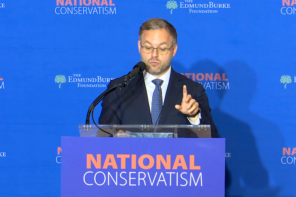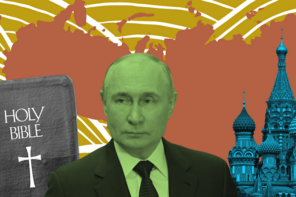It’s a weird story, even in 2020—and that’s saying something. Father Sergey, a COVID-denying conspiracy-spewing Russian monk, had, with the help of an ad hoc personal army that includes veterans of the recent conflicts in Ukraine, seized control of the women’s monastery in the Ural mountains he’d founded. Now, he’s been excommunicated. But the story isn’t over.
There’s plenty of reason to believe that the official Russian Orthodox Church won’t be able to rein him in, even now. The civil authorities have proven ineffective against him; a police visit to the monastery turned up no violations of the secular law. It’s understandable that a Western audience would find this story thoroughly bizarre. Peak 2020, if you will.
But within the Eastern Christian tradition it’s just not that weird. It is, in fact, quite unsurprising as there’s a long history of renegade holy men within the Eastern Christian world. This tradition is largely unknown in the West, but it’s a practice that is very much alive from the halls of the Kremlin to the deserts of Arizona.
Orthodox Christianity has a crazy holy man problem, a problem that from time to time becomes a problem for those outside the frequently medieval world of the Christian East. And while Father Sergey is unlikely to make life difficult for those of us who aren’t one of the now-displaced abbesses, it’s a problem that we would all do well to keep our eyes on. Because even Vladimir Putin has his own renegade holy man.
The spiritual father knows best
The trouble arises from what’s actually one of the more humane and helpful customs of Orthodox Christianity: the spiritual father. (There are technically spiritual mothers as well, but the exclusion of women from the ordained clergy has historically kept their numbers small.) Deriving from the ancient Egyptian monastic tradition (the oldest in the Christian world), it’s common practice for pious Orthodox Christians to take a spiritual father, a man to whom they not only offer their confession but also seek out for guidance, both spiritual and temporal.
These relationships ideally (and frequently in practice) endure over decades and even lifetimes, and they’re frequently more intimate and stable than the ones that develop between laity and the typically more transitory figures of parish priests and local hierarchs. Cognizant of this deeper relationship, the Orthodox Church’s hierarchy has historically deferred to the spiritual father with respect to a lay member’s participation and standing in the Church. It is traditionally, therefore, your spiritual father who acts as the first and most important gatekeeper to such central practices as Holy Communion, marriage, and ordination.
The Orthodox Church has among its clergy both monastics and married men. Married priests are forbidden from the episcopate and have historically served as parish priests. The Church hierarchy, though technically monastic, has always been a sort of distinct “career path,” one more given to pursuits associated with a politician than a monk. The Church’s other monastics, however, are a different story.
In the Egyptian desert, on the Aegean peninsula* of Mt. Athos, and the far reaches of Russia’s vast steppe, the Orthodox monastic tradition is ancient, acestic, and—perhaps most importantly—autonomous. While technically under the authority of local bishops, the reality is that Orthodoxy’s monastic communities have operated in parallel independence to parish life, developing their own customs, practices, and (though few would be willing to admit it) beliefs.
And it’s among these monastics that many Orthodox Christians, particularly the most pious, have found their spiritual fathers. Moreover, the most popular of these geron—roughly equivalent to a Roman Catholic cardinal—have fairly frequently developed significant followings far beyond the intimate, and by necessity, scarce relationships of spiritual fathers to their spiritual children.
And this is where the problem lies. Because of the traditional and institutional weight (vis-a-vis the sacraments) given to the geron, the situation arises in which a man with significant spiritual and ecclesiasstical authority is allowed to operate largely independently, exercising significant control over his followers essentially unchecked. It’s a situation ripe for abuse. And instances when such abuses have emerged are not particularly hard to find.
Everybody’s favorite Orthodox holy man
Perhaps the most famous instance in which the Orthodox holy man went horribly awry is the case of Grigori Rasptuin. Born to a peasant family from Serbia, Rasputin rose to become the spiritual father of the Tsar Nicholas II and his wife Tsarina Alexandra. He held no official position in the Orthodox Church, a fact that did not undermine his authority largely because of a long history of tolerance and even celebration of extra-eccesialstical holy men not only within Orthodox cultures, but also by the institutional church. The tsarina in particular attributed magical powers to the monk, believing he was responsible for keeping the hemophiliac heir, Tsarivich Alexi, alive. Rasputin’s lack of an official role coupled with the real power he was able to amass demonstrates one of the flaws in Orthodoxy’s monastic tradition, in which autonomy affords position with little oversight.
Rasputin’s influence on the imperial couple was not popular at court, particularly as the First World War dragged on and the Tsarina increasingly relied on him to fill the void left by the Tsar who was stationed at the front. It was a disdain that both common people and nobility shared and which helped fuel other resentments toward the monarchy. A group of nobles, led by Prince Felix Yusupov and Grand Duke Dmitri Pavlovich, assassinated Rasputin in 1916, but the ill-will he created lingered. His presence had separated the royal family from their natural allies in the nobility and on the political right, while simultaneously providing the Communists with ample propaganda material that called into question both the monarchy and the Church. It’s not too much of a stretch to argue that some part of the cause of the Russian Revolution can be found in the strange holy man from Siberia.
An Arizona renegade
But you don’t need to travel back to early 20th-century Russia to find an example of a destructive Orthodox monk superstar. Just outside the town of Florence, Arizona, 63 miles southeast of Phoenix, in the middle of the desert, stands St. Anthony’s Monastery. Though built to resemble the great monastic houses of the medieval Christian East, there’s something too clean, too luxurious about St. Anthony’s to pass muster. It’s the mother house of 18 monasteries that, until his death last December, were all more or less under the direct control of one man: Elder Ephraim of Arizona—a controversial figure even in death. Viewed by many of his followers as a saint and prophet, his critics accused him of being a dangerous cult leader, whose radical brand of asceticism and unquestioned authority among his followers continues to threaten the fabric of Orthodox Christianity in America and the safety of his adherents.
The Greek-born Elder Ephraim was tonsured as a monk in 1947 on Mount Athos, an isolated monastic republic in the Aegean which forbids not only women, but even cows, from landing on its shores. He left Athos in 1979 when he went to Canada for medical treatment. From there, he came to the United States, which is (as with so many stories) where it gets weird.
Traveling through the Greek-American communities of the early 1980s, Ephraim found what through other eyes might have seemed like The Great American Success story. During the twentieth century, Greeks had arrived in the United States in two waves: The first in the early decades of the century and then again in the immediate aftermath of the Second World War. On both occasions, they had left a land ravaged by war, occupation, and economic chaos.
Within a generation, their children and grandchildren had not only entered the middle-class, but had risen to be counted among the wealthiest and most well-educated Americans. But this affluence and success looked like anything but to the austere monk, who saw among the Greeks of America ample evidence that in attaining wealth they had found spiritual poverty and abandoned the Orthodox faith of their ancestors. Someone had to save them and Ephraim decided he was the monk for the job. He was on a mission from God. But first he needed permission from another higher authority.
The spiritual leader of the Greek Orthodox faithful in America resides 5,277 miles from American shores in the Turkish city of Istanbul. Of course, before it was Istanbul it was Constantinople, the imperial capital of the Greek, Christian Byzantine Empire. That’s why the Ecumenical Patriarch still resides there, in faded glory and behind enemy lines, after more than 500 years.
It was to Patriarch Demetrios I that Ephraim first applied for permission to create a monastery in the style of Mount Athos in the American desert. When the Patriarch refused, the monk did something that is, at best, a violation of the Orthodox Church’s arcane canon law, and at worst an indication of a character so certain of his own righteousness that he was unlikely to ever be restrained in any case.
Denied permission by his own hierarch, Ephraim looked for friendlier faces, which he found among the Russian Orthodox Church Outside of Russia (ROCOR). Begun as a breakaway sect in the aftermath of the Russian Revolution, ROCOR is known for a kind of fundamentalism that can really only survive among those who see themselves as the last remnant of Holy Mother Russia. Most importantly, in the 1980s ROCOR wasn’t in communion with any other Orthodox churches. They were renegades. And not the sort of people that pious Greek monks should have been anywhere near. And yet, it’s from ROCOR that Ephraim received his initial blessing to found St. Anthony’s.
The road to tragedy
Within a year the Patriarch of Constantinople backtracked and Ephraim and St. Anthony’s jurisdictional problems were resolved by the early 1990s. But the ordeal at the origin of Elder Ephraim’s American project continues to cast a long shadow. If for no other reason than because the normal ways in which Orthodox hierarchs might act to restrain the more questionable among their flock have proven powerless with Ephraim. No matter how far the monk went, no one seemed able to stop him.
And he went quite far. His preaching included a strident sexual morality, end-times prophecies and truly outrageous antisemitism. Elder Ephraim regularly made mention of the Protocols of the Elders of Zion, a fabricated antisemitic text (first published in Russia, by the way) that’s grabbed the attention of everyone from Henry Ford to those who wrote the Nazi German school curiculum. The Greek Orthodox Archdiocese routinely denied Ephraim’s antisemitism, in the face of overwhelming evidence. It was their only strategy of dealing with the increasingly rogue monk.
The result was tragedy. Scott Nevins was a convert to Orthodox Christianity and had once been a novice at St. Anthony’s for six years when he shot himself just one mile from the monastery’s grand central driveway. It’s a shocking and bizarre story that frankly goes a long way to support the claim that what Elder Ephraim was really leading was a cult.
When Nevins first encountered Ephraim he was a young former high school stand out. Healthy and handsome, he was the picture of the sort of American optimism that Ephraim clearly found distasteful. Within a year of his joining the monastery, a local Arizona TV news story captured Nevins who is, in the brief glimpses of the camera, clearly a shadow of his former self. Thin, pale, bowed down.
According to his family, it wasn’t just Scott’s physical appearance that diminished during his time at St. Anthony’s. His communication with his family and friends was limited. He became paranoid and obsessed with conspiracy theories (to be certain, conspiratorial thinking is par for the course among the monks of Mount Athos and their spiritual children). Finally, after six years at the monastery, Nevins fled in the middle of night, hitchhiking down the desert roads that led away from St. Anthony’s.
Scott Nevins had physically escaped, but he was still captive emotionally. He set up a website in which he decried Elder Ephraim as an abusive cult leader. He also grew obsessed about possessions that he’d left behind, including a retainer, and in June of 2012 he bought two guns and drove back to Arizona. To St. Anthony’s. He entered the monastery grounds and was approached by the monk working security that night. When approached, he panicked and drove away. The security guard-monk followed him until Nevins stopped his car, got out, and shot himself. He was twenty-seven years old.
Scott Nevins’s death is impossible to separate from the influence of Elder Ephraim, which is strikingly similar to the influence of these other Orthodox holy men over their followers. So it should command our attention that Vladimir Putin has one of his own charismatic spiritual fathers. Metropolitan Tikhon is rare among Orthodox holy men in that he holds an episcopal position within the Church. That being said, he’s hardly a company man. For example, in addition to his role as a churchman, he’s a bit of a filmmaker. His documentary Death of An Empire: Lessons from Byzantium won the Russian equivalent of an Oscar in 2008 and outlines a view of history that has gained a great deal of currency among the global far-right.
An archconservative, Tikhon has routinely highlighted the fact that the chief executioner of the Romanovs was Jewish, tying the assasination of the Russian royals to ancient charges of blood-libel. He’s a prolific blogger and serves as editor-in-chief of a website, an activity not terribly common among either monks or bishops. Additionally, he supports the annexation of Crimea and holds deeply anti-European and anti-Western views. This is the man who has the ear of Vladimir Putin and his soul in his hands.
Renegade monks make for outrageous, sensational, or funny stories—except when they’re dangerous. And it’s not always easy to know when that line will be crossed.
*Correction: Despite the fact that Mt. Athos has traditionally been described as an island it isn’t technically an island, as the article initially stated. Were the author permitted, as a woman, to enter the peninsula she may not have made the mistake. Still, RD and the author regret the error.





